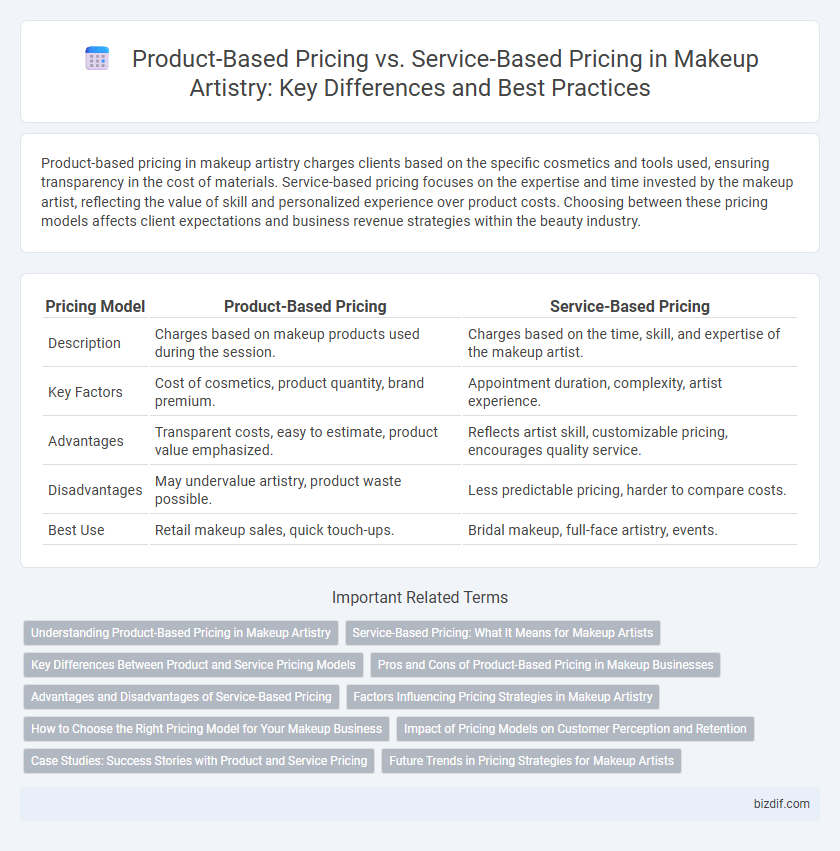Product-based pricing in makeup artistry charges clients based on the specific cosmetics and tools used, ensuring transparency in the cost of materials. Service-based pricing focuses on the expertise and time invested by the makeup artist, reflecting the value of skill and personalized experience over product costs. Choosing between these pricing models affects client expectations and business revenue strategies within the beauty industry.
Table of Comparison
| Pricing Model | Product-Based Pricing | Service-Based Pricing |
|---|---|---|
| Description | Charges based on makeup products used during the session. | Charges based on the time, skill, and expertise of the makeup artist. |
| Key Factors | Cost of cosmetics, product quantity, brand premium. | Appointment duration, complexity, artist experience. |
| Advantages | Transparent costs, easy to estimate, product value emphasized. | Reflects artist skill, customizable pricing, encourages quality service. |
| Disadvantages | May undervalue artistry, product waste possible. | Less predictable pricing, harder to compare costs. |
| Best Use | Retail makeup sales, quick touch-ups. | Bridal makeup, full-face artistry, events. |
Understanding Product-Based Pricing in Makeup Artistry
Product-based pricing in makeup artistry involves setting prices according to the cost and value of the cosmetics and tools used during the service, including brand allocation and quantity applied. This pricing method requires careful calculation of product usage per client, incorporating factors such as premium product lines like MAC, NARS, and Pat McGrath, which directly influence profit margins. Understanding product-based pricing enables makeup artists to maintain profitability while providing transparency in charges related to the beauty products applied.
Service-Based Pricing: What It Means for Makeup Artists
Service-based pricing for makeup artists involves charging clients based on the time, skill level, and personalized experience provided rather than the cost of products used. This approach allows artists to account for the complexity of different makeup styles, session durations, and client consultations, ensuring fair compensation for their expertise. Adopting service-based pricing can enhance perceived value, foster client trust, and streamline income predictability in competitive beauty markets.
Key Differences Between Product and Service Pricing Models
Product-based pricing in makeup artistry focuses on the cost of physical items like cosmetics and tools, often calculated by markup on wholesale prices to cover expenses and profit margins. Service-based pricing centers on the artist's time, skill level, and complexity of the makeup application, typically charged as hourly rates or flat fees for specific looks or events. Key differences include tangible inventory costs in product pricing versus intangible labor valuation in service pricing, influencing how makeup artists structure their overall revenue strategies.
Pros and Cons of Product-Based Pricing in Makeup Businesses
Product-based pricing in makeup artistry allows businesses to set prices based on the cost and perceived value of makeup products, ensuring profitability on high-quality or exclusive items. This strategy can attract clients who prefer premium products but may alienate budget-conscious customers and limit flexibility in pricing customized services. Managing inventory costs and potential product wastage also presents challenges, making product-based pricing less adaptable for fluctuating market demands in the makeup industry.
Advantages and Disadvantages of Service-Based Pricing
Service-based pricing in makeup artistry allows for tailored charges reflecting the complexity and time invested in each session, enhancing client satisfaction and justifying higher fees for bespoke work. However, this model can result in income inconsistency and challenges in estimating job duration, potentially complicating scheduling and profitability. Artists must balance flexibility with strategic time management to maximize earnings while maintaining quality service.
Factors Influencing Pricing Strategies in Makeup Artistry
Factors influencing pricing strategies in makeup artistry include the cost of high-quality cosmetics, brand reputation, and the level of expertise required for specialized services. Product-based pricing emphasizes the expense and exclusivity of makeup products used, while service-based pricing is determined by the duration, complexity, and personalization of the makeup application. Market demand, client preferences, and competitive pricing also play critical roles in shaping how makeup artists structure their fees.
How to Choose the Right Pricing Model for Your Makeup Business
Choosing the right pricing model for your makeup business depends on understanding client preferences and service complexity. Product-based pricing works well for selling exclusive beauty products or customized makeup kits, leveraging product value to enhance revenue. Service-based pricing suits personalized makeup applications and event styling, focusing on time, expertise, and client experience to maximize profit and satisfaction.
Impact of Pricing Models on Customer Perception and Retention
Product-based pricing in makeup artistry often leads customers to perceive value in tangible goods, which can enhance initial trust but may result in transactional relationships that challenge long-term retention. Service-based pricing emphasizes skill and personalized experience, fostering stronger client loyalty and higher satisfaction by highlighting the artist's expertise and customized approach. Balancing these pricing models strategically impacts customer perception by aligning cost with perceived value, ultimately influencing repeat bookings and brand reputation.
Case Studies: Success Stories with Product and Service Pricing
Case studies in makeup artistry reveal that product-based pricing drives revenue growth by highlighting premium, branded cosmetics, generating higher profit margins and customer loyalty. Service-based pricing excels in personalized makeup sessions, where tailored experiences lead to repeat clients and elevated referrals, reflecting increased value perception. Successful artists often combine both pricing models, leveraging product sales during appointments and premium services, optimizing overall income and client satisfaction.
Future Trends in Pricing Strategies for Makeup Artists
Product-based pricing in makeup artistry emphasizes the cost of cosmetics and tools, appealing to clients who value tangible luxury and personalized product selections. Service-based pricing focuses on the expertise and time of the makeup artist, catering to clients prioritizing professional skill and customized looks. Future trends indicate a hybrid pricing strategy leveraging AI-driven analytics to tailor rates based on client preferences, occasion complexity, and product exclusivity, enhancing transparency and customer satisfaction.
Product-based pricing vs Service-based pricing Infographic

 bizdif.com
bizdif.com